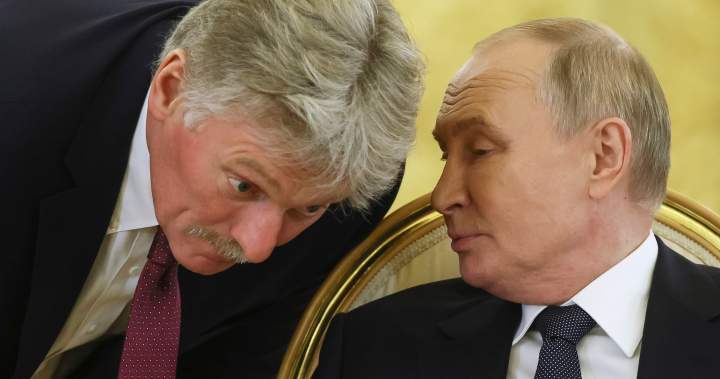The Kremlin’s latest peace overture comes wrapped in familiar conditions, as Moscow signals willingness to engage in negotiations while simultaneously demanding Ukrainian territorial concessions that Kyiv has repeatedly rejected as non-starters.
Speaking to reporters yesterday, Kremlin spokesman Dmitry Peskov outlined Russia’s position: negotiations remain possible, but only if Ukraine accepts “new territorial realities” – diplomatic shorthand for ceding control of regions Russia claims to have annexed despite incomplete military control and international recognition.
“We remain open to a diplomatic resolution,” Peskov stated, “but Ukraine must acknowledge current territorial realities and withdraw forces from all four new Russian regions.” This refers to Donetsk, Luhansk, Zaporizhzhia, and Kherson, where Russia held widely condemned referendums in 2022.
During my recent visit to Kyiv, the reaction to such proposals was uniformly dismissive. “Russia starts talking peace whenever they need to regroup militarily,” a senior Ukrainian defense official told me, speaking on condition of anonymity. “Their definition of peace is our surrender. That’s not negotiation – it’s dictation.”
The timing of Moscow’s statements coincides with what Western intelligence sources describe as significant Russian military challenges. The Russian offensive in Kharkiv has stalled, ammunition constraints are affecting artillery capabilities, and personnel shortages continue despite ongoing mobilization efforts.
President Volodymyr Zelensky’s administration has maintained its position that any negotiations must be based on Ukraine’s sovereignty and territorial integrity. During a press conference last week, Zelensky emphasized, “We cannot negotiate away our people or our land. That would only guarantee future Russian aggression.”
International reaction remains cautiously skeptical. A senior NATO official I spoke with in Brussels characterized Russia’s approach as “tactical diplomacy” rather than genuine peace-seeking. “They’re trying to drive wedges between Ukraine’s supporters while continuing their fundamental objective of dismantling Ukrainian statehood,” the official said.
The human cost of this diplomatic deadlock continues to mount. In Kharkiv, I witnessed firsthand the aftermath of recent Russian strikes on civilian infrastructure. Olena, a 67-year-old grandmother who lost her home last month, expressed the civilian perspective: “They destroy our homes with missiles, then talk about peace. What kind of peace comes after destruction?”
According to UN monitoring reports, civilian casualties now exceed 10,000 dead since Russia’s full-scale invasion began in February 2022, with millions displaced internally and externally.
Economic factors increasingly influence both sides’ calculations. Russia’s war economy has proven more resilient than initially expected, despite Western sanctions. The International Monetary Fund recently revised its growth forecasts for Russia upward to 3.2% for 2024, though structural weaknesses remain.
Ukraine, meanwhile, continues to depend heavily on Western financial support. The recent approval of a $61 billion U.S. aid package provided critical breathing room, but European officials warn that sustainable financing mechanisms remain uncertain.
Chinese and Brazilian mediation efforts have gained limited traction, with Beijing’s “peace plan” viewed skeptically by Kyiv and Western capitals due to its perceived alignment with Russian objectives. President Lula da Silva’s suggestion of territorial compromises was promptly rejected by Ukrainian officials.
Military analysts point to the summer months as potentially decisive. “Both sides are preparing for significant operations,” explains Oleksandr Danylyuk, former secretary of Ukraine’s National Security and Defense Council. “Russia hopes to exhaust Ukraine’s defensive capabilities, while Ukraine seeks to demonstrate it can continue inflicting unsustainable costs on the invading forces.”
For civilians caught in the conflict zones, peace talks remain abstract while daily survival is concrete. In Kherson, where Russian forces continue shelling Ukrainian positions from across the Dnipro River, local administrator Serhiy described pragmatic priorities: “We’re not discussing peace terms here. We’re discussing where to get drinking water and how to evacuate the elderly.”
The fundamental incompatibility between Russian and Ukrainian positions suggests any immediate breakthrough remains unlikely. Ukraine’s insistence on full territorial restoration and security guarantees contrasts sharply with Russia’s demands for Ukrainian territorial concessions and “neutrality.”
As spring transitions to summer in Eastern Europe, the diplomatic theater continues its performance while the war’s brutal realities unfold in towns and villages across Ukraine’s contested regions. The gap between peace talk and peace reality has rarely seemed wider.






